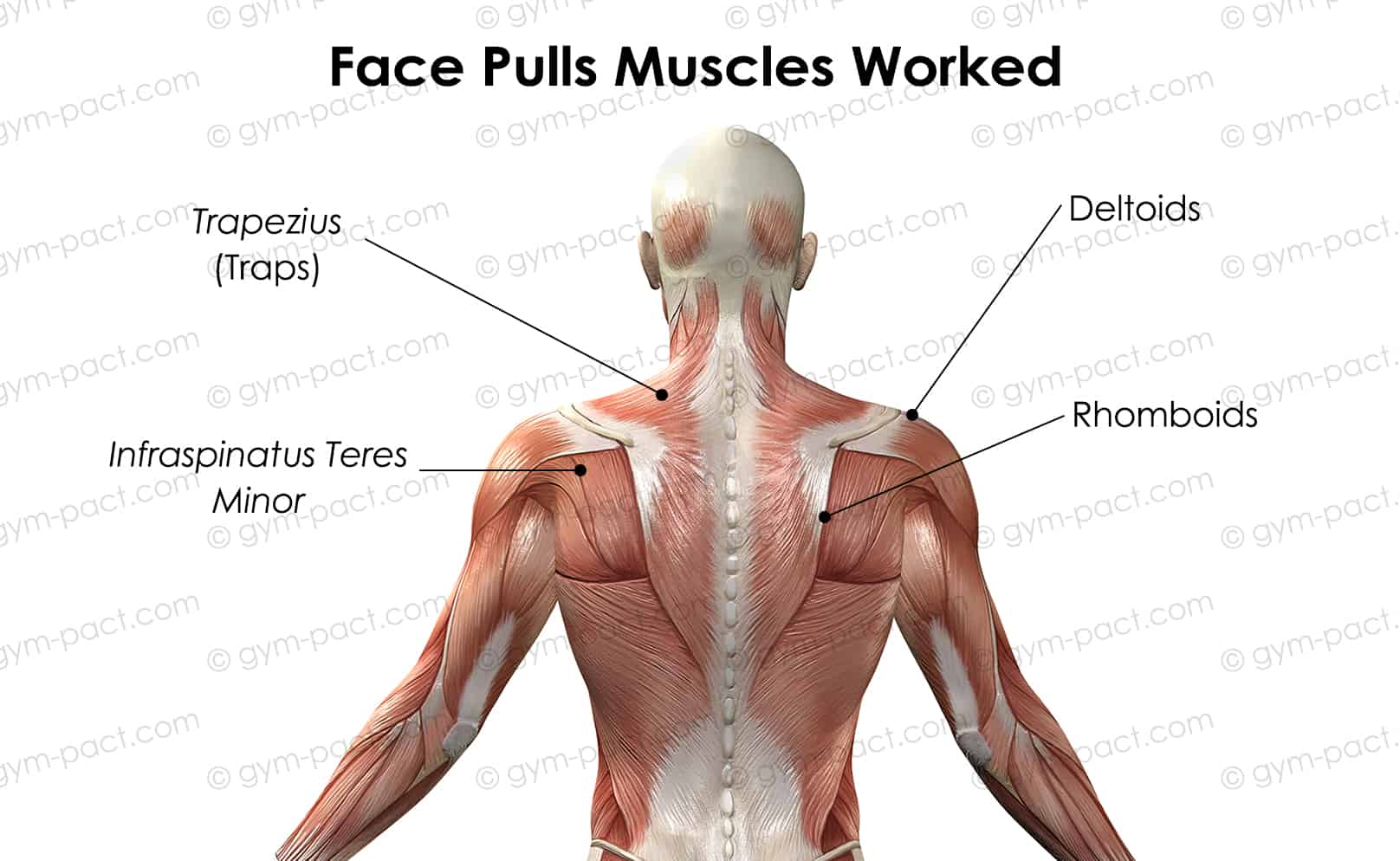What muscles does the face pull work?
When you think of a list of exercises that develop strength and build size, I bet the face pull wasn’t on the list. The face pull is an exercise that strengthens the primary muscle groups of the shoulders and upper back. It specifically targets the rhomboids, trapezius, deltoids, and the infraspinatus teres minor, which are the rotator cuff’s small stabilizer muscles.

Although not a popular movement amongst most gym-goers, athletes with experience regularly implement the face pull into their training programs. Without getting too scientific, it’s crucial to understand the complex movement, which is the face pull so as to avoid pain and unwanted injury.
The movement is caused by combining what we call “transverse abduction”, which takes place from the lateral and posterior deltoids and external rotation instigated by the teres minor.
Common Mistakes to Avoid
As with most human movement activities, there are some common mistakes to avoid. Performing the exercise with incorrect form is the most prominent mistake gym users make when executing the face pull.
Another common mistake to avoid is loading the weight stack to heavy; this causes your technique to suffer causing potential pain in the deltoids, rhomboids, and upper back.
The face pull exercise can be a challenging movement to learn and execute. This article looks at some variations of the face pull movements, and in particular, those that do not require the use of a cable machine.
Best Face Pulls Alternative
1. Resistant Bands Upright Row
The resistant band upright row is an exercise I included in numerous female professional tennis players’ training programs. It’s the perfect activity for those looking for a low-impact movement who may not have access to a cable machine. Athletes such as tennis players have high demands placed on the body, so an exercise like the resistant band row offers another face pull alternative and provides an increased range of motion.
Equipment:
Resistance Bands
Primary Muscles:
Delts, Traps, Upper Body, Shoulder Joint
How to perform:
- Grab an extra-long resistance band and anchor it to the floor using either a door attachment or simply stand in the middle of the band.
- Make sure your feet are shoulder-width apart and your arms are extended. Be careful not to lock the elbows out; keep your chest puffed out and your head straight.
- Now, grab the band shoulder-width apart using an overhand grip and slowly bring the resistance band up towards your chest.
- Keeping a strong core and being careful not to hunch your shoulders, lower the band, and return to the starting position.
- Repeat.
Coaches Tip:
This is an excellent cable face pull alternative due to the limited impact it has on the body. Perfect for either a warm-up or cooldown and great for those who are looking to improve the range of motion.
Sets and Reps:
3 sets of 12 reps
2. Seated Shoulder Press With Band
This workout should command your attention, especially if you are looking for a practical face pull that promotes shoulder health. The band has many benefits, primarily being the constant tension on the band throughout the entire workout which is not present when performing on a cable pulley machine.
Equipment:
Band
Primary Muscles:
Shoulders, Lats, Delts, Arms
How to perform:
- This exercise can be performed seated or standing. If standing, place your feet in the middle of the band. If using the seated version, wrap the band under the chair’s seat.
- With your palms facing forward, grab each end of the resistance band and make sure your feet are in an athletic position with your feet shoulder-width apart.
- Now slowly press upwards, bringing the band over your shoulders or as high as you feel comfortable.
- Once at the top of the movement, pause for a 2-sec count, then slowly lower back down.
- Repeat.
Coaches Tip:
Because the band places less stress on the shoulder joint, you can perform more reps than the traditional weighted version. If you have a significant amount of training experience look to perform between 12-15 repetitions.
Sets and Reps:
3 sets of 12-15
3. Lateral Raise
The lateral raise is one of the best cable face pull-ups alternatives, and it offers several benefits to the user, including strengthening the shoulder, extended mobility, and increased flexibility. You’ll be surprised at just how challenging the lateral raise is to perform; using a lightweight helps with the movement’s consistency and the range.
Equipment:
Dumbbells or Resistance Band
Primary Muscles:
Shoulder, Traps, Delts
How to perform:
- Stand up straight with your feet shoulder-width apart, and knees slightly bent in an athletic position.
- The dumbbells should be held with an overhand grip and relaxed at your side.
- Now slowly raise the weight up and out to the side, engaging the core.
- When your arms reach parallel, slowly lower back to the starting position in a controlled manner to avoid injury. Make sure to keep a slight bend in your elbows.
- Repeat.
Coaches Tip:
Keep the weight light, going heavy will force you to hunch your back muscles and shoulders resulting in loss of form and an increased chance of injury.
Sets and Reps:
3 sets of 12 reps
4. External Rotation
The external rotation movement strengthens the external rotators found in the shoulder. There are four rotators in total, two of them being external; these external rotators are critical when it comes to stabilizing the shoulder muscle and joint and are essential for a range of motion.
This is the perfect exercise for those who may be suffering from shoulder pain as the movement promotes range. Those undergoing rehabilitation will also find this exercise very useful as it helps the smaller stabilizing muscles recover without putting them under unwanted stress.
Equipment:
Resistance Band
Primary Muscles:
Shoulder, Delts, Lats
How to perform:
- This external rotation exercise can be performed standing or seated. If standing, make sure your feet are shoulder-width apart and as always, be sure to maintain an athletic stance with a slight bend in your knees.
- Grab the band in each hand at shoulder height, with your palms facing upwards and between 3-5 inches apart.
- Your elbows should be at 90 degrees and tucked in close to your body.
- Without moving your elbows, pull the band away from your hands in the opposing direction, stop when the band is stretched.
- Slowly control the movement back to the starting position with your core engaged and your head straight.
Coaches Tip:
The external rotation movement can place stress on the shoulder joints so don’t be afraid to go lighter. However, if performed correctly, the movement is a powerhouse in developing overall shoulder, lat, and external rotation stability.
Sets and Reps:
3 sets of 12
5. Superman
This iconic bodyweight movement, as the name suggests, will leave you feeling like superman or superwoman. It develops the muscle group of the lower back, shoulders, and core and provides an excellent stretch throughout the entire body. Being a bodyweight movement, the superman can be performed anywhere, making it a very accessible exercise.
Equipment:
None
Primary Muscles:
Upper Body, Lower Back, Glutes, Core
How to perform:
- Lay down on your stomach with your arms stretched out in front (exactly as superman would)
- Make sure the midsection is anchored to the floor.
- Slowly lift your legs and arms up off the floor by engaging your core, lower back, and your glutes.
- When reaching the top of the movement, pause for 2 seconds, and then return to the starting position.
- Repeat.
Coaches Tip:
When performing the superman, keep both your feet and hands off the ground at the same height; this creates a smooth curve down the back of your spine. If raising both legs and arms simultaneously is too challenging, consider switching to the one leg one arm version. In this version, when you raise your right leg, you raise your left arm while simultaneously increasing the range of movement within your body.
Sets and Reps:
3 sets of 12 reps.
6. One Arm Resistant Band Press
The primary difference when utilizing the resistance band compared to traditional weights is that it challenges your body to stabilize the opposing side. These exercises are referred to as “unilateral” and stimulate strength by improving the range of motion.
Equipment:
Resistance Band
Primary Muscles:
Shoulders, Delts, Lats
How to perform:
- With one foot, stand in the middle of the band as you would for a banded biceps curl.
- Explosively press the resistance band up over your head while making sure to engage the core. When exploding up, rotate your hands slightly to help activate the front and side delts.
- At the top of the movement, pause for a 2-second count the return to the start.
Coaches Tip:
To make the exercise more challenging, athletes add resistance to the band, you can do this one of 3 ways. First, change to a more resistant band; secondly, widen your stance on the band and finally loop the band around your opposite foot to create more resistance.
Sets and Reps:
3 sets of 12 reps
7. Single Arm Resistant Band Lateral Raise
The single-arm lateral raise is the perfect exercise for those looking for a movement that isolates the shoulders for maximum development. By working on one side at a time, you force your body to stabilize itself and therefore improve balance. This movement is excellent if you have had previous shoulder joint pain as the bands put little to no stress on the joints.
Equipment:
Resistance Band
Primary Muscles:
Shoulders, Delts, Lats, Core
How to perform:
- Put your right foot in the center of the resistance band. Now Step forward using your opposite foot, engage the core, and keep your back straight.
- With a slight bend in your elbows, raise the band up and out to the side of your body.
- At the top of the movement, your arms should be parallel to the ground; here, pause for a 2-second count to reap the full benefits of the contraction.
- Return to the starting position and repeat on the opposite side.
Coaches Tip:
Focus your thoughts on executing the exercise with impeccable form. Resistance bands provide tension throughout the entire movement, which puts maximum workload on the shoulders with minimal stress, making this perfect for those undergoing rehabilitation or the elderly.
Sets and Reps:
3 sets of 12
Conclusion
As you can see from the information provided in this article, the face pulls and the face pull alternatives are excellent shoulder exercises that offer a range of positive benefits, including overall shoulder health.
As with most muscle groups, the maximum development is attained by implementing a variety of different exercises. Varying the regularity and intensity also helps promote strength and stability.
Although the face pull is not the most popular exercise, it plays a crucial role in shoulder strength, stabilization, muscle imbalance, and works to prevent shoulder injuries. As mentioned earlier, everyday exercises like pushing, pressing, and rotating are enhanced when face pulls are consistently utilized in an athlete’s training program.
One final benefit to these alternatives is the additional work your core muscles receive while performing face pulls; this is because most of the face pull exercises are performed while standing, meaning you are constantly using the core muscles to stabilize.
Frequently Asked Questions
Can You Do Face Pulls With Dumbbells?
With a pair of dumbbells, take an overhand grip, place your chest against the bench and extend your arms, so the dumbbells are hanging.
Now, bring your shoulder blades together in a rowing fashion and slightly let your elbows flare to the side.
Hold the movement for a 2-second pause at the top with your forearms parallel to your shoulders.
Slowly lower back down in a controlled action and repeat.
Are Face Pulls Necessary?
The face pull is an excellent exercise that hits the rear delts, traps, and upper back muscles. Contrary to belief, face pulls are great for developing thickness throughout the upper back and rear delts, which helps with regular daily activities such as rotating and lifting. If performed correctly, face pulls are a potent exercise that has also been linked to relieving back and neck pain.
Do Face Pulls Build Muscle?
This question seems to pop up a lot. Although not the most popular or glamorous movement, the face pull hits several different muscle groups, including the shoulders and upper back. I recommend implementing the face pull into your training program to help balance out the various movements you currently utilize. The bench press and overhead press may be popular and offer more benefits; however, that does not mean you should neglect the face pull exercise.
Are Face Pulls For Back Or Shoulders?
The face pull emphasizes the development of the shoulders or “rear delts,” the rhomboids, and the teres minor located in the rotator cuff to a lesser degree. These muscles are extremely critical in maintaining rotation range of movement and strength throughout the shoulders, which could help those who steer clear of pressing activities such as push-ups or the bench press.







